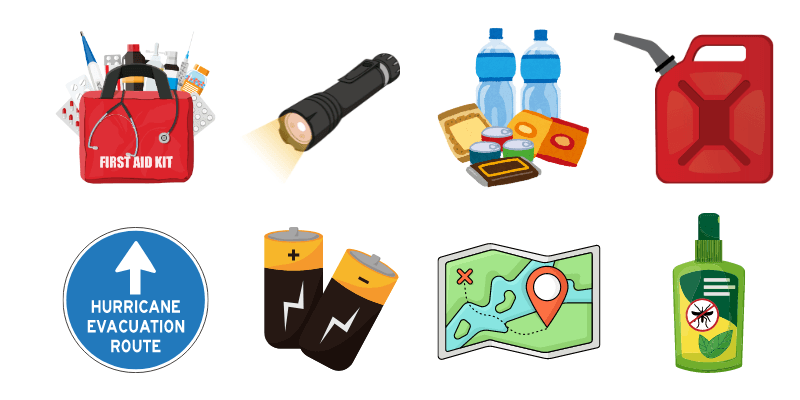
The Eye of the Storm
Proactive Guide to Facility PreparednessThe Hurricane Season has already arrived with massive floods in the Southeast. Near-record warm ocean temperatures in the Atlantic are creating more energy to fuel storm development.
To gather the best hurricane preparedness tips, we visited five Florida organizations, including a healthcare facility, a utility company, a university, a Tribal Nation and a County government.
Each conversation yielded unique and proactive ways these teams gear up for storms. From specialized procedures to innovative strategies, we learned a lot about staying safe and ready for the storm, and now we’re ready to share their expertise with you.
The common theme from these conversations? Preparedness is the first step toward resilience.
Comprehensive Hurricane Preparedness Checklist for Facilities Teams

Pre-Season Preparation (December - May)
Review and Update Plans
- Review and update the hurricane preparedness plan.
- Conduct annual inventory checks.
- Update emergency contact lists.
- Ensure emergency procedures are proactive and well-documented
Contracts and Compliance
- Ensure all contracts follow FEMA requirements.
- Secure pricing agreements for critical supplies and services.
- Confirm mutual aid agreements with local/state municipalities, businesses, colleges, and universities
- Include agreements for diverse supplies such as different sizes of tarps and chainsaws, based on lessons from past events.
Vendor Coordination
- Meet with vendors to discuss pre-staging resources.
- Ensure multiple vendors for critical supplies.
- Confirm availability of backup power sources and fuel supplies.
- Regularly coordinate with vendors to discuss pre and post storm preparation
Training and Exercises
- Conduct preseason meetings with internal and external stakeholders.
- Participate in emergency management training and exercises.
- Ensure staff are trained in weather spotting and emergency response procedures.
- Conduct regular training sessions and damage assessment team kickoffs

Weekly Monitoring During Hurricane Season (June - November)
Weather Monitoring
- Monitor weather updates from the National Weather Service (NWS) and National Hurricane Center (NHC).
- Use radar tracking apps and emergency communication software for alerts.
- Ensure all weather spotters are actively monitoring conditions.
- Revise decisions based on changing weather patterns
Communication Readiness
- Test communication systems, including emergency communication software, radios, cell phones, and satellite phones.
- Ensure all departments maintain emergency supplies and have communications plans accessible
- Maintain consistent communication within the team and critical external parties
Resource Allocation
- Check and replenish emergency supplies, including food, water, and medical supplies.
- Ensure generator fuel tanks are full and replenished from previous storms
- Verify/test backup power systems
- Utilize devices such as iPads to manage tasks and track progress during emergencies.

72 Hours Before Predicted Storm Impact
Activation of Emergency Operations Center (EOC)
- Activate the EOC and notify all relevant personnel.
- Confirm roles and responsibilities for all departments.
- Set up incident command centers and staging sites.
- Coordinate the deployment of ride-out and debris teams.
Secure Facilities
- Begin securing loose materials and equipment.
- Install shutters and secure windows and doors.
- Ensure all exterior drainage systems are clear.
- Ensure facilities that house people are secured.
Staff Coordination
- Implement staff rotation schedules to prevent burnout.
- Ensure staff have personal emergency kits and necessary supplies.
- Confirm lodging and meal arrangements for staff staying on-site.
- Maintain detailed checklists and team member assignments.
Communication and Coordination
- Activate emergency communication software notifications and confirm receipt by all team members.
- Coordinate with local and state emergency management agencies.
- Establish regular communication updates with all stakeholders.
- Emphasize the importance of coordination and clear communication channels.
48 Hours Before Predicted Storm Impact
Facility Evacuation (if necessary)
- Make the decision to decompress or fully evacuate the facility.
- Follow the process for secure relocations and storage.
- Coordinate with ambulance services and healthcare providers for patient relocation, if applicable
- Ensure research samples and critical materials are relocated or secured, if applicable
Final Preparations
- Double-check all emergency supplies and equipment.
- Secure all critical documents and electronic data backups.
- Ensure all power banks and backup batteries are charged.
- Confirm readiness of teams and supplies.
Communication Systems
- Verify all communication lines are open and functional.
- Update all personnel on the latest storm track and safety procedures.
- Test and confirm communication reliability and redundancy (radios, cell phones, satellite phones, Internet)
24 Hours Before Predicted Storm Impact
Initial Preparations
- Emergency meeting to review plan and assign roles
- Update contact information and establish communication protocols
- Monitor weather updates
Facility Securing
- Secure loose exterior objects
- Close and secure windows/doors, board up if needed
- Place sandbags at vulnerable entry points
Interior Preparations
- Test generators, ensure fuel tanks are full
- Protect critical systems, relocate or secure equipment
- Move valuable items to higher ground
Communication and Coordination
- Brief staff on latest updates and responsibilities
- Confirm emergency contacts, establish check-in times
- Review and communicate evacuation plans
Final Checks
- Power down non-essential systems
- Secure interior doors and loose items
- Conduct final walkthrough to ensure preparations are complete
During the Storm
Shelter in Place
- Ensure all personnel are in designated safe areas.
- Maintain regular check-ins and status updates through emergency communication software.
- Monitor weather conditions and adjust safety protocols, as necessary.
- Provide continuous updates to ensure situational awareness.
Emergency Response
- Activate backup power systems as needed.
- Ensure continuous operation of critical medical and safety equipment.
- Provide regular updates to staff and external stakeholders.
- Maintain communication and coordination as the situation evolves.
Post-Storm Recovery
Damage Assessment
- Conduct initial damage assessments as soon as it is safe.
- Use signage and/or caution tape to mark buildings as safe/unsafe
- Use digital tools and/or paper checklists to document and report damage.
- Coordinate with FEMA and insurance agents for assessments and claims.
Restoration of Services
- Begin cleanup and repair of facilities.
- Prioritize restoration of power, water, and critical infrastructure.
- Ensure all safety systems are functional before resuming normal operations.
Staff Support
- Provide support and resources for staff impacted by the storm.
Continuous Improvement
Review and Revise Plans
- Update hurricane preparedness plans based on feedback and new insights.
- Incorporate new technologies and strategies based on recent experiences.
- Maintain ongoing training and readiness programs for all staff.
- Emphasize a culture of continuous learning and improvement.
- Incorporate continuous improvement strategies for future readiness.
Community and Vendor Engagement
- Strengthen relationships with local businesses, colleges, and emergency agencies.
- Ensure continuous communication and collaboration with all stakeholders.
- Participate in community drills and preparedness activities.
- Foster a network of support and resource sharing.

Storm Insights & Observations
The facility professionals who’ve experienced hurricanes know what to expect. They’ve practiced, rehearsed, and reviewed what works, what doesn’t work, and how to improve moving forward. There’s a sense of selflessness among these folks. Everyone has defined responsibilities, no one person is working harder and longer hours, and the best teams support each other and the people they care for throughout these epic events, and during recovery.
Check out our popular on-demand webinar: Hurricane Preparedness: Insights from the Eye of the Storm, where David Trask shared best practices gathered from facilities teams at 5 Florida organizations. And here is a digital checklist you can use to stay prepared for hurricanes before, during and after.
